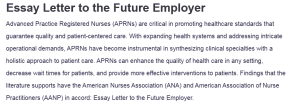Essay Letter to the Future Employer
Advanced Practice Registered Nurses (APRNs) are critical in promoting healthcare standards that guarantee quality and patient-centered care. With expanding health systems and addressing intricate operational demands, APRNs have become instrumental in synthesizing clinical specialties with a holistic approach to patient care. APRNs can enhance the quality of health care in any setting, decrease wait times for patients, and provide more effective interventions to patients. Findings that the literature supports have the American Nurses Association (ANA) and American Association of Nurse Practitioners (AANP) in accord: Essay Letter to the Future Employer.
Evidence has shown that APRNs significantly contribute to filling patients’ myriad needs. The American Association of Nurse Practitioners (2019) noted that nurse practitioners (NPs), a sub-group of APRNs, provide high-quality continuation of acute and chronic care and a large amount of preventive care. Most primary care physicians do not need extra time for health education in their usual practice, while NPs concentrate on this aspect of care.
These treatment approaches reinforce the preventive measures of health that patients with multiple chronic conditions require. This has been attributed to better adherence to their self-care and medication regimens and better health outcomes attributed to integrated care (Fernandez-Lazaro et al., 2019).
Notably, incorporating APRNs into a healthcare system is another advantage of APRNs since it is cost-effective. Substantiated by Liu et al. (2020), the cost of patients under the care of NPs is relatively equal to that of patients under the care of physicians. Remarkably, these patients had insignificant inpatient services, suggesting that NPs’ care entails fewer hospitalizations. This outcome implies that APRNs can help control healthcare costs yet deliver a level of care comparable to that of physicians, thus making them sustainable for high-quality and accessible healthcare.
Subsequently, the greater impact of APRNs lies in areas that primary care physicians do not well serve. The ANCC (2019) reports that about 89% of nurse practitioners are educated and certified in primary care, with about 70% practicing in that realm. Primary care NPs tend to practice more frequently than physicians in medically underserved and rural areas, reducing health disparities and improving access to care. This commitment to underserved communities supports health equity and aligns with the mission of healthcare organizations, whose goals are to provide comprehensive care to all populations.
APRNs bring added knowledge and skill beyond primary care, enhancing healthcare delivery within various specialties. According to Buppert (2018), APRNs possess clinical skills necessary for diagnosing, managing, and treating varied patient conditions independently or in collaboration with physicians. In so doing, APRNs can provide a wide range of cases, from routine assessment to more complex disease management, thereby affecting health teams’ proper utilization of resources. Therefore, APRNs’ versatility improves efficiency in healthcare teams, saving physicians for cases where advanced specialization is required.
Consequently, the ANA insists on maximizing the scope of practice for all health professionals, particularly APRNs, to respond to an increasingly aging population and increased costs in health care (ANA, 2024). As healthcare settings continue to work on responding to these emerging needs, APRNs are well prepared to contribute to such care through their advanced training in comprehensive health assessment, patient education, and interdisciplinary care. By embracing the full scope of APRN practice, healthcare organizations can tap into this expertise, improving patient outcomes and addressing many critical healthcare challenges.
In conclusion, hiring an APRN is a strategic, suitable investment that benefits patients and healthcare organizations. Evidence supports that APRNs provide care equal to and, in some cases, even better than physicians, particularly in preventive care and chronic disease management. Notably, APRNs’ availability in underserved communities increases access to health care; their relative cost-effectiveness provides an economical mode for extending quality care. Additionally, Advanced Practice Registered Nurses are significant assets in any healthcare team, bringing advanced knowledge, compassionate care, and dedication toward the well-being of patients, falling nothing short of the highest standards of healthcare.
References
American Association of Nurse Practitioners. (2019). Position Statements. American Association of Nurse Practitioners; AANP Website. https://www.aanp.org/advocacy/advocacy-resource/position-statements
ANA. (2024). Advanced Practice Registered Nurses (APRN) . ANA. https://www.nursingworld.org/practice-policy/workforce/what-is-nursing/aprn/
ANCC. (2019). Nursing certifications: Our Certifications. ANA. https://www.nursingworld.org/our-certifications/
Buppert, C. (2018). Nurse practitioner’s business practice and legal guide (6th ed.). Jones & Bartlett Learning. https://lccn.loc.gov/2016047295
Fernandez-Lazaro, C. I., García-González, J. M., Adams, D. P., Fernandez-Lazaro, D., Mielgo-Ayuso, J., Caballero-Garcia, A., Moreno Racionero, F., Córdova, A., & Miron-Canelo, J. A. (2019). Adherence to treatment and related factors among patients with chronic conditions in primary care: A cross-sectional study. BMC Family Practice, 20(1), 1–12. https://doi.org/10.1186/s12875-019-1019-3
Liu, C., Hebert, P. L., & Douglas, J. H. (2020). Outcomes of primary care delivery by nurse practitioners: Utilization, cost, and quality of care. Health Services Research, 55(2), 178–189. https://doi.org/10.1111/1475-6773.13246
ORDER A PLAGIARISM-FREE PAPER HERE
We’ll write everything from scratch
Question 
A. Write a statement or essay (1-2 pages) to your future employer with a rationale why hiring the APRN brings added value to their practice
- Include supporting data from a research study in promoting the APRN profession to the employer
- Review documents from professional organizations, such as the American Nurses Association or the American Academy of Nurse Practitioners.
- Suggested resources:
- Reference articles (include at least 5 articles illustrating the roles and quality of care provided by nurse practitioners) (include links to articles if possible

Essay Letter to the Future Employer
